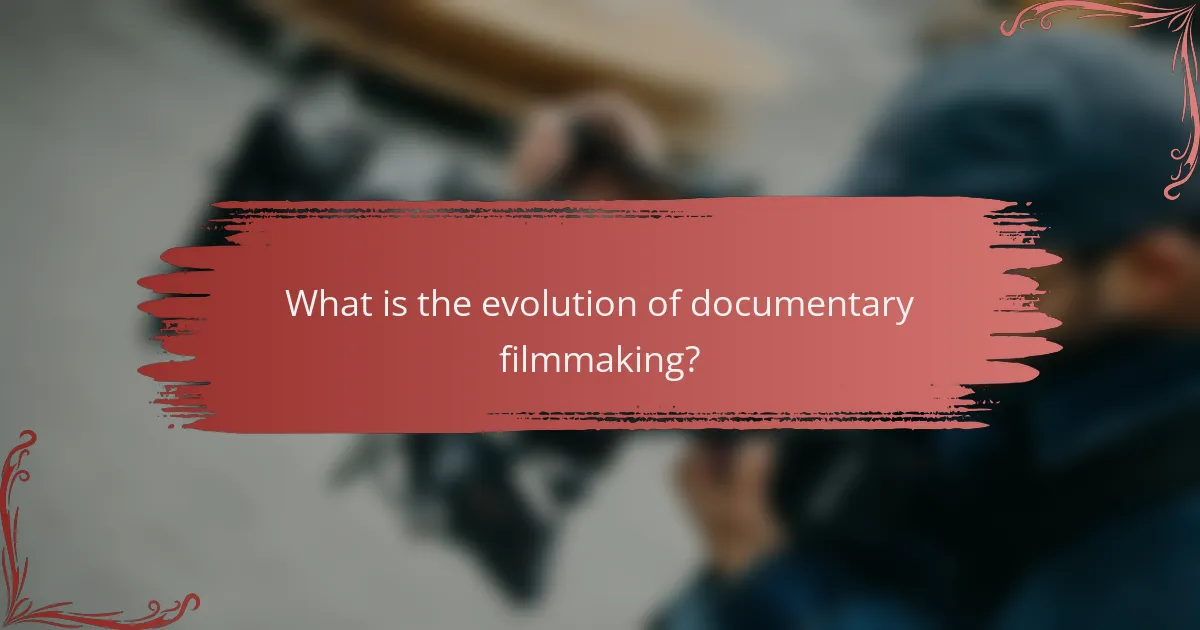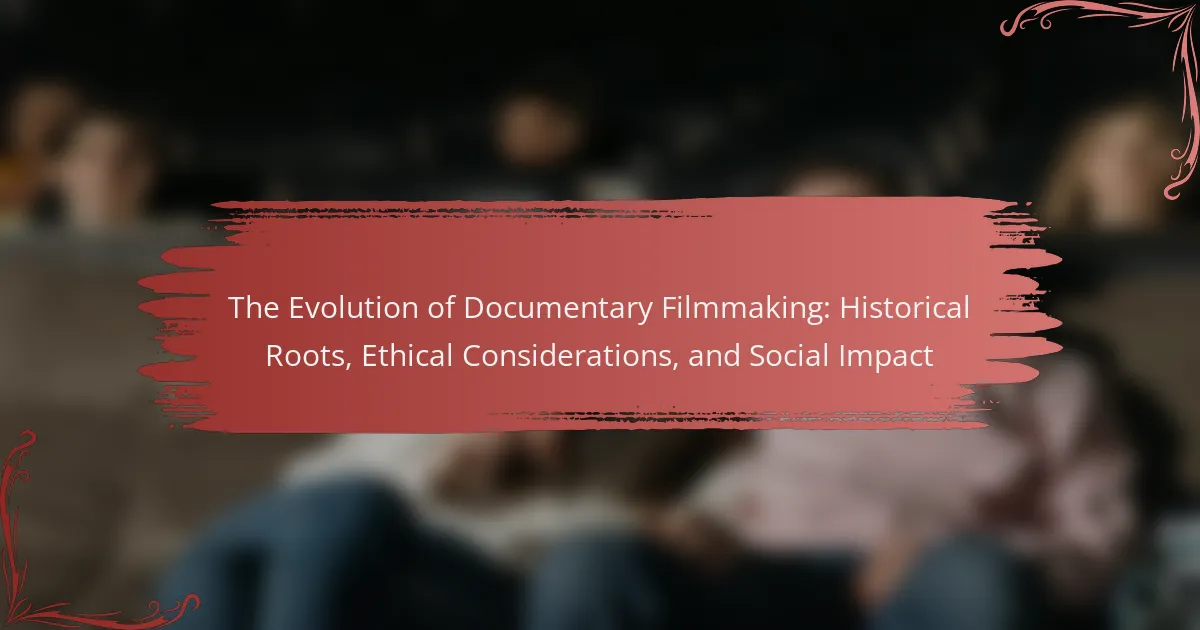Documentary filmmaking has undergone significant evolution since its origins in the late 19th century, transitioning from straightforward depictions of real-life events to more complex narratives that blend artistic expression with factual storytelling. Key developments include the emergence of direct cinema and cinema verité in the 1960s and 1970s, which emphasized authenticity and minimal interference, and the democratization of the medium in the 1990s due to technological advancements. Contemporary documentaries address a wide range of social issues, utilizing innovative storytelling techniques while grappling with ethical considerations such as honesty, representation, and consent. This genre plays a vital role in shaping public discourse, influencing social change, and giving voice to marginalized communities, ultimately fostering informed discussions on critical societal values.

What is the evolution of documentary filmmaking?
Documentary filmmaking has evolved significantly since its inception in the late 19th century. Early documentaries, such as those by the Lumière brothers, focused on capturing real-life events in a straightforward manner. The 1920s introduced more artistic approaches, exemplified by Robert Flaherty’s “Nanook of the North,” which blended narrative and documentary styles.
The 1960s and 1970s saw the emergence of direct cinema and cinema verité, emphasizing observational techniques and minimal interference. This period highlighted the importance of authenticity and the filmmaker’s role in shaping narratives.
In the 1990s, technological advancements, including digital cameras and editing software, democratized filmmaking. This allowed a broader range of voices and stories to emerge. The rise of the internet further transformed documentary filmmaking, leading to the popularity of web documentaries and social media platforms for distribution.
Today, documentaries address diverse social issues and incorporate innovative storytelling methods. They continue to influence public discourse and shape cultural narratives, reflecting the ongoing evolution of the genre.
How has documentary filmmaking changed over the decades?
Documentary filmmaking has evolved significantly over the decades. In the early 20th century, documentaries primarily focused on factual reporting and educational content. The style was often straightforward, with limited narrative techniques. By the 1960s, filmmakers began experimenting with more subjective storytelling approaches. This era introduced the use of personal perspectives and emotional engagement. The advent of portable cameras in the 1970s allowed for more intimate and spontaneous filming.
In the 1990s, the rise of digital technology transformed production and distribution. Filmmakers gained access to affordable equipment and editing software. This democratization led to a surge in independent documentaries. The 2000s saw the emergence of online platforms, expanding audiences and accessibility. Today, documentaries often blend genres, incorporating elements of drama and fiction. The focus has shifted to diverse topics, reflecting global issues and personal narratives. Overall, documentary filmmaking has transitioned from traditional formats to innovative, multifaceted storytelling.
What were the early forms of documentary filmmaking?
Early forms of documentary filmmaking include actuality films and travelogues. Actuality films captured real-life events and everyday activities. They emerged in the late 19th century, with pioneers like the Lumière brothers. Travelogues documented exotic locations and cultures, often narrated by the filmmaker. These films became popular in the early 20th century, showcasing the world to audiences. Both forms laid the groundwork for the documentary genre. They emphasized authenticity and observation, key elements in later documentaries.
How did technological advancements influence documentary styles?
Technological advancements significantly influenced documentary styles by changing production techniques and accessibility. The introduction of lightweight cameras in the 1960s allowed filmmakers to capture spontaneous moments. This shift led to the development of direct cinema and cinéma vérité styles. Digital technology further transformed documentaries, enabling high-definition visuals and editing flexibility. The rise of the internet and streaming platforms expanded distribution options for documentaries. This accessibility encouraged diverse voices and subjects to emerge in the documentary landscape. Overall, technology has continually shaped how stories are told and experienced in documentary filmmaking.
What are the key historical milestones in documentary filmmaking?
The key historical milestones in documentary filmmaking include the invention of the cinematograph in 1895. This technology allowed filmmakers to capture real-life events. In 1922, Robert Flaherty released “Nanook of the North,” often considered the first feature-length documentary. The 1930s saw the rise of the documentary movement with films like “The Plow That Broke the Plains” by Pare Lorentz. The 1960s introduced direct cinema with filmmakers like the Maysles brothers, emphasizing observational techniques. The 1980s and 1990s brought about the use of personal narratives, as seen in “Sherman’s March” by Ross McElwee. In the 2000s, digital technology transformed documentary filmmaking, increasing accessibility and reach. These milestones reflect the evolution of the genre in both technique and storytelling.
Which influential filmmakers shaped the documentary genre?
Influential filmmakers who shaped the documentary genre include Robert Flaherty, John Grierson, and D.A. Pennebaker. Robert Flaherty is known for his film “Nanook of the North,” released in 1922. This film is often considered the first feature-length documentary. John Grierson coined the term “documentary” and produced influential works like “Night Mail” in 1936. D.A. Pennebaker is recognized for his direct cinema approach, exemplified in “Don’t Look Back,” which chronicles Bob Dylan’s 1965 tour. These filmmakers introduced innovative techniques and narrative styles that significantly impacted documentary filmmaking. Their contributions laid foundational principles that continue to influence the genre today.
What significant events impacted the development of documentaries?
The development of documentaries was significantly impacted by several key events. The invention of the motion picture in the late 19th century laid the foundation for documentary filmmaking. The establishment of the documentary genre was further advanced by Robert Flaherty’s “Nanook of the North” in 1922, which is often considered the first feature-length documentary. The rise of television in the mid-20th century expanded the audience for documentaries, allowing for more diverse storytelling. The 1960s saw the emergence of direct cinema and cinema verité, emphasizing observational techniques. The introduction of portable cameras and sound equipment during this period allowed filmmakers to capture reality more authentically. The 1980s and 1990s brought a surge in documentary popularity due to cable television networks like PBS and HBO. The advent of digital technology in the 2000s democratized filmmaking, enabling more individuals to create and distribute documentaries. Each of these events played a crucial role in shaping the documentary film landscape as we know it today.
Why is understanding the historical roots of documentary filmmaking important?
Understanding the historical roots of documentary filmmaking is important because it provides context for the genre’s development. This context highlights how early filmmakers shaped narrative techniques and ethical considerations. For instance, the works of pioneers like Robert Flaherty and John Grierson established foundational principles. These principles continue to influence contemporary practices in documentary storytelling. Additionally, historical awareness informs filmmakers about past societal issues and audience perceptions. This knowledge aids in creating relevant and impactful content today. Understanding these roots fosters a critical approach to the ethical implications of documentary filmmaking. Ultimately, it enhances the appreciation of the genre’s evolution and its role in society.
How do historical contexts shape documentary narratives?
Historical contexts significantly shape documentary narratives by influencing the themes, perspectives, and storytelling techniques used. Documentaries often reflect the social, political, and cultural issues of their time. For instance, films made during the Civil Rights Movement highlighted racial injustices and activism. This context provided a framework for filmmakers to address pressing societal concerns. Additionally, historical events can dictate the availability of footage and testimonies, impacting narrative construction. Documentaries about World War II often use archival materials to convey the gravity of the conflict. The historical backdrop also determines audience reception and interpretation. Viewers might engage differently with a documentary based on their understanding of the era depicted. Overall, historical contexts serve as a lens through which documentary narratives are crafted and understood.
What lessons can modern filmmakers learn from past documentaries?
Modern filmmakers can learn the importance of authenticity from past documentaries. Early documentaries often prioritized real-life events and genuine storytelling. For instance, Robert Flaherty’s “Nanook of the North” emphasized capturing the true essence of its subjects. Filmmakers should also recognize the value of narrative structure. Documentaries like “The Thin Blue Line” demonstrated how compelling storytelling can reshape public perception. Additionally, ethical considerations are crucial. Past filmmakers faced scrutiny over representation and consent, highlighting the need for transparency. Lastly, the impact of social context in documentaries is significant. Films like “The Act of Killing” illustrate how historical events can provoke dialogue and change. These lessons emphasize the need for integrity, storytelling, ethics, and social awareness in modern documentary filmmaking.

What ethical considerations arise in documentary filmmaking?
Ethical considerations in documentary filmmaking include honesty, representation, and consent. Filmmakers must present subjects truthfully without manipulation. Misrepresentation can lead to harm, especially for vulnerable communities. Consent is crucial; subjects should understand how their stories will be used. Privacy issues also arise, particularly in sensitive topics. Filmmakers must balance artistic expression with ethical responsibilities. Transparency about funding sources and potential biases is essential. Ethical breaches can undermine public trust in documentaries.
How do filmmakers balance truth and storytelling?
Filmmakers balance truth and storytelling by blending factual accuracy with narrative techniques. They often use creative storytelling to engage audiences while presenting real events or issues. This approach can involve dramatization, selective editing, and perspective framing. For instance, documentaries may include reenactments to illustrate historical events. Filmmakers also prioritize emotional resonance to connect viewers with the subject matter. This can sometimes lead to ethical dilemmas regarding representation and authenticity. Balancing these elements requires careful consideration of the audience’s perception of truth. Ultimately, the aim is to inform while also captivating the viewer’s interest.
What are the potential ethical dilemmas faced during production?
Potential ethical dilemmas faced during production include issues of consent, representation, and exploitation. Filmmakers must obtain informed consent from subjects. This is crucial when documenting sensitive topics. Misrepresentation can occur if subjects are portrayed inaccurately. This can lead to harm or stigma for individuals or communities. Exploitation arises when filmmakers profit from vulnerable populations without fair compensation. Additionally, the balance between artistic expression and ethical responsibility is often challenged. Filmmakers must navigate these dilemmas to maintain integrity and respect for their subjects. Historical examples highlight these ethical challenges, emphasizing the need for responsible practices in documentary filmmaking.
How can filmmakers ensure integrity in their work?
Filmmakers can ensure integrity in their work by adhering to ethical standards and transparency. This includes accurately representing subjects and avoiding manipulation of facts. Filmmakers should conduct thorough research and fact-checking to support their narratives. They must obtain informed consent from participants featured in their films. Additionally, maintaining a clear distinction between documentary and fictional elements is crucial. Following established guidelines from organizations like the International Documentary Association reinforces ethical practices. Documentaries that uphold integrity contribute to public trust and social impact.
Why are ethical guidelines important in documentary filmmaking?
Ethical guidelines are crucial in documentary filmmaking to ensure integrity and respect for subjects. They help filmmakers navigate complex moral dilemmas while telling true stories. Ethical guidelines protect the rights and dignity of individuals featured in documentaries. They promote transparency and honesty in representing facts and perspectives. Adhering to these guidelines fosters trust between filmmakers and audiences. A notable example is the Society of Professional Journalists’ Code of Ethics, which emphasizes accuracy and fairness. Following ethical standards can prevent exploitation and misrepresentation in storytelling. This commitment ultimately enhances the credibility of the documentary genre.
What are the consequences of unethical practices?
Unethical practices in documentary filmmaking lead to significant consequences. These consequences include loss of credibility and trust among audiences. Documentaries rely on factual representation to engage viewers. When filmmakers distort facts, they undermine their authority. This can result in negative public perception and backlash. Filmmakers may face legal repercussions for misrepresentation. In some cases, unethical practices can harm the subjects portrayed. This can lead to emotional distress or reputational damage. Overall, unethical practices jeopardize the integrity of the documentary genre.
How can adherence to ethics enhance audience trust?
Adherence to ethics enhances audience trust by ensuring transparency and integrity in documentary filmmaking. Ethical practices build credibility with viewers. When filmmakers are honest about their methods and intentions, audiences feel more secure in the information presented. This trust fosters a deeper connection between the filmmaker and the audience. Studies show that documentaries perceived as ethical are more likely to be well-received and shared. For example, a survey by the International Documentary Association found that 78% of viewers prioritize ethical considerations in documentary content. Thus, ethical adherence is crucial for establishing and maintaining audience trust.

What is the social impact of documentary filmmaking?
Documentary filmmaking has a significant social impact by raising awareness about important issues. It educates audiences on social, political, and environmental topics. Documentaries can influence public opinion and inspire social change. For instance, “An Inconvenient Truth” brought attention to climate change, leading to increased environmental activism. Documentaries often give a voice to marginalized communities. They can challenge stereotypes and promote empathy. According to a study by the University of Southern California, documentaries can alter viewers’ perceptions and increase engagement in social issues. Thus, documentary filmmaking plays a crucial role in shaping societal values and fostering informed discussions.
How do documentaries influence public opinion and awareness?
Documentaries influence public opinion and awareness by presenting factual narratives that engage viewers emotionally and intellectually. They often highlight social issues, injustices, or underrepresented perspectives. For instance, the documentary “Blackfish” raised awareness about the treatment of orcas in captivity, leading to significant public outcry and changes in policy. Research shows that documentaries can shift attitudes; a study by the University of California found that watching documentaries can increase empathy and awareness of social issues by 30%. This impact stems from their ability to combine storytelling with factual evidence, making complex topics accessible and relatable.
What role do documentaries play in social movements?
Documentaries serve as powerful tools for social movements by raising awareness and mobilizing support. They present real-life stories and issues, making complex subjects accessible to a wider audience. For instance, films like “The Act of Killing” shed light on human rights abuses, prompting public discourse. Documentaries can also document events and provide historical context, which is crucial for understanding social issues. According to a study by the University of Southern California, documentaries significantly influence viewers’ perceptions and can inspire activism. They often highlight marginalized voices, ensuring diverse perspectives are represented. By combining emotional storytelling with factual evidence, documentaries can effectively drive social change.
How can documentaries drive change in society?
Documentaries can drive change in society by raising awareness about critical issues. They inform viewers about topics often overlooked by mainstream media. For instance, the documentary “An Inconvenient Truth” significantly influenced public perception of climate change. It led to increased environmental activism and policy discussions. Documentaries also inspire empathy by showcasing personal stories and struggles. This emotional connection can motivate viewers to take action. Additionally, documentaries can serve as a call to action, encouraging community involvement. They have the power to shape public discourse and influence decision-makers. Overall, documentaries play a vital role in promoting social justice and reform.
What are some notable examples of socially impactful documentaries?
Notable examples of socially impactful documentaries include “13th,” “Blackfish,” and “The Act of Killing.” “13th” explores the intersection of race, justice, and mass incarceration in the United States. Directed by Ava DuVernay, it reveals how systemic racism has shaped American history. “Blackfish” examines the ethical implications of keeping orcas in captivity. It particularly focuses on the story of Tilikum, an orca involved in human fatalities. “The Act of Killing” challenges former Indonesian death squad leaders to reenact their real-life killings. This documentary highlights the psychological impact of violence and impunity. Each of these films has sparked significant public discourse and policy discussions.
How did specific documentaries change perceptions on key issues?
Specific documentaries have significantly changed perceptions on key issues by presenting compelling narratives and factual evidence. For instance, “An Inconvenient Truth” raised awareness about climate change. It featured data showing rising global temperatures and melting ice caps. This documentary influenced public opinion and policy discussions on environmental issues. Similarly, “Blackfish” highlighted the ethical concerns of keeping orcas in captivity. It led to increased scrutiny of marine parks and changes in public attitudes towards animal welfare. Documentaries like “13th” examined systemic racism in the U.S. criminal justice system. It sparked conversations about race and inequality, leading to greater activism and reform efforts. These examples demonstrate how documentaries can shift societal views and inspire action on critical topics.
What are the measurable effects of documentaries on policy and action?
Documentaries can significantly influence policy and action by raising awareness and shaping public opinion. They often highlight social issues, prompting discussions among viewers. For instance, the documentary “An Inconvenient Truth” led to increased public concern about climate change. This resulted in policy shifts, including the adoption of the Kyoto Protocol. Research shows that 70% of viewers felt more informed about environmental issues after watching it. Additionally, documentaries like “13th” have spurred conversations on criminal justice reform. These films can mobilize communities and encourage grassroots activism. Overall, documentaries serve as catalysts for change by informing audiences and influencing decision-makers.
What best practices should filmmakers follow to maximize social impact?
Filmmakers should prioritize authenticity and representation to maximize social impact. Authentic storytelling resonates more deeply with audiences. This involves engaging with communities featured in the film. Filmmakers must ensure diverse voices are included in the narrative. Collaboration with experts can enhance credibility and depth. Utilizing social media can amplify the film’s message and reach broader audiences. Filmmakers should also create educational resources to accompany their films. These resources can facilitate discussions and action. Measuring the film’s impact through audience feedback and engagement is crucial. This data can inform future projects and strategies.
How can filmmakers engage their audience effectively?
Filmmakers can engage their audience effectively by creating relatable content. They should focus on storytelling that resonates with viewers’ experiences. Incorporating emotional elements helps establish a connection. Engaging visuals and sound design enhance the overall experience. Interactive elements, such as audience participation, can deepen engagement. Filmmakers can also utilize social media to promote discussions around their films. According to a study by the Sundance Institute, films that foster community engagement have higher audience retention rates. This demonstrates that effective engagement strategies can lead to a more invested audience.
What strategies can be employed to ensure a documentary resonates with viewers?
To ensure a documentary resonates with viewers, filmmakers should focus on storytelling, emotional engagement, and authenticity. A compelling narrative structure captures attention and maintains interest. Emotional connections can be established through relatable characters or impactful events. Authenticity enhances credibility and fosters trust with the audience. Research indicates that documentaries that evoke strong emotions are more likely to be remembered and discussed. According to a study by the University of Southern California, emotionally resonant films lead to higher viewer engagement and retention. By combining these strategies, a documentary can effectively connect with its audience.
The main entity of the article is documentary filmmaking, which has undergone significant evolution from its origins in the late 19th century. The article outlines key historical milestones, including the shift from straightforward factual reporting to more artistic and subjective storytelling techniques, particularly during the 1960s and 1970s. It also examines the impact of technological advancements on production and distribution, which democratized the genre and diversified narratives. Ethical considerations are highlighted, emphasizing the importance of authenticity, representation, and consent in documentary practices. Finally, the article discusses the social impact of documentaries, illustrating how they raise awareness, influence public opinion, and drive social change.
